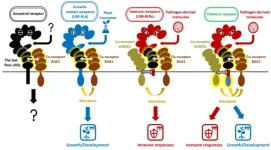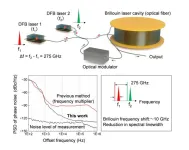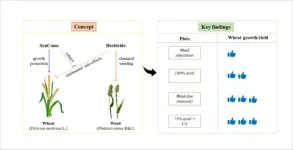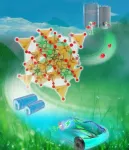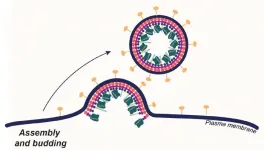Plant receptors that control immunity and development share a common origin
2024-02-01
(Press-News.org)
Plants are continuously evolving new immune receptors to ever-changing pathogens. Researchers at the RIKEN Center for Sustainable Resource Science (CSRS) have traced the origin and evolutionary trajectory of plant immune receptors. Their discovery will make it easier to identify immune receptor genes from genomic information and could help in the development of pathogen-resistant crops. This study was published in the scientific journal Nature Communications on February 1.
As in animals, plants have immune responses that help them defend against pathogens such as viruses, bacteria, fungi, and oomycetes. Before invaders can be stopped, they must first be detected, and this is accomplished by pattern recognition receptors located on the surface of plant cells. The ability of these receptors to detect molecular patterns associated with pathogens depends on two types of proteins, called RLPs and RLKs, both of which can contain leucine-rich repeats—sections in which the amino acid leucine appears multiple times.
To trace the evolution of plant immunity, the international research team led by Ken Shirasu and Yasuhiro Kadota at RIKEN CSRS examined the numbers and patterns of receptors. They analyzed over 170,000 genes encoding RLKs and about 40,000 genes encoding RLPs, which they obtained from publicly available data taken from 350 plant species. They discovered that RLKs and RLPs with leucine-rich repeats were the most abundant receptor types among all the plant species, making up nearly half of RLKs and 70% of RLPs.
RLPs, and some RLKs, are known to contain a special island region that is crucial for recognizing parts of pathogens. Investigation by the RIKEN CSRS team revealed that among RLPs that contain the leucine-rich repeats, this special region was almost always located in the same place; between the 4th and 5th leucine-rich repeat. These RLPs were found to be associated with immune responses. They also discovered that the island region was located at the same position in some RLKs, nearly all of which belong to a functional group that regulates growth and development.
Comparative analysis showed that the sequence of the four repeats below the island region was very similar between the two types of protein detectors, suggesting that they have a common evolutionary ancestry. In particular, these four sets of leucine repeats contained sections needed for bonding to the same co-receptor, called BAK1. This means that immunity-related RLPs and growth-related RLKs inherited the ability to bind BAK1 from a common ancestor.
“Intriguingly, we found that exchanging the four regions of leucine-rich repeats among these receptors did not disrupt their functionality,” says Bruno Pok Man Ngou, who conducted the study. Creating a hybrid receptor by combining a growth-related RLK with an immunity-related RLP resulted in a hybrid receptor that recognized pathogens and induced both immune and growth-related responses. This means that scientists should be able to engineer receptors with new functions by swapping those modules.
This study addressed the origins of plant immunity at a molecular level, showing that simultaneously analyzing information from multiple plant genomes can allow straightforward and precise prediction of genes involved in plant immunity and growth. “We are currently isolating immune receptors from various plants using this information, aiming for practical applications such as developing disease-resistant crops in the future,” says Shirasu.
END
ELSE PRESS RELEASES FROM THIS DATE:
2024-02-01
The renowned virologist from the University of Zurich receives the major award from the Bill & Melinda Gates Foundation for an innovative project on HIV vaccines. The grant will fund vaccine studies in well-studied groups of people living with HIV in Switzerland and South Africa to guide the design of a preventative HIV vaccine.
Alexandra Trkola, Professor of Medical Virology at the University of Zurich, has been awarded a 3-year grant (INV-061559) from the Bill & Melinda Gates Foundation for the project “RENEW clinical studies in people with HIV”. Together with her co-principal investigators Huldrych Günthard (University Hospital Zurich and UZH), Penny Moore (University ...
2024-02-01
Our energy systems are undergoing rapid change. Many households are generating electricity with solar panels, and there are new sources of demand and storage, such as charging electric vehicles and home batteries. Local prosumers (energy consumers who also generate and store energy) are taking control of their own energy supply. This development is prompting the creation of energy communities and micro-grids, such as the SchoonSchip community in the north of Amsterdam.
Energy communities allow consumers ...
2024-02-01
Mangroves and saltmarshes sequester large amounts of carbon, mitigating the greenhouse effect. New research from the University of Gothenburg shows that these environments are perhaps twice as effective as previously thought.
Natural habitats flooded by the tide form ecosystems that captures large amounts of carbon, which can help to mitigate climate change. Carbon dioxide is stored in the biomass and in the muddy soils. Therefore, several governments have launched blue carbon market initiatives to encourage landowners to restore and preserve mangrove and saltmarsh ecosystems, similar to the rainforest.
Large ...
2024-02-01
Nestling songbirds relocated as part of conservation programmes successfully learn the song repertoires they need to communicate – and ultimately survive – in the wild, a new study has found.
The research, published in the journal Conservation Science and Practice, is the first to follow translocated songbird chicks over time to assess their song development.
It focused on populations of cirl buntings (Emberiza cirlus), taken from a number of sites in Devon before being hand-reared and then reintroduced in Cornwall as part of a major programme co-ordinated ...
2024-02-01
Unexplained rapid weight loss in older people could be a sign of underlying disease and can be linked with increased risk of falls and fractures, as well as a poorer long-term prognosis.
The understanding of factors that could contribute to rapid weight loss remains poor, with current treatments including correcting suboptimal dietary and physical activity behaviors.
New research by Edith Cowan University (ECU) Postdoctoral Research Fellow Dr Cassandra Smith noted that abdominal aortic calcification (AAC), a marker of advanced blood vessel disease, was linked to higher risk of rapid weight ...
2024-02-01
Osaka, Japan – From coffee-shop customers who connect their laptop to the local Wi-Fi network to remote weather monitoring stations in the Antarctic, wireless communication is an essential part of modern life. Researchers worldwide are currently working on the next evolution of communication networks, called “beyond 5G” or 6G networks. To enable the near-instantaneous communication needed for applications like augmented reality or the remote control of surgical robots, ultra-high data speeds will be needed on ...
2024-02-01
Synthetic microbial communities (SynComs) are emerging as powerful allies in the battle against weeds. These carefully crafted assemblies of microorganisms, such as compatible Pseudomonas strains, are designed to target specific weeds while promoting crop growth. The application of herbicides with SynComs will be essential to understand their synergistic effects for controlling weed and promoting wheat growth, so that provides a sustainable and eco-friendly weed control strategy. By harnessing the collective strength of Pseudomonas SynComs, this research brings us ...
2024-02-01
Supercapacitors, also known as ultracapacitors or electric double-layer capacitors (EDLCs), are advanced energy storage devices with unique characteristics. Unlike traditional batteries, supercapacitors store energy through the electrostatic separation of charges at the interface between an electrolyte and a high-surface-area electrode. This mechanism allows for rapid energy storage and release, enabling supercapacitors to deliver high power bursts and exhibit exceptional cycle life.
Supercapacitors play a pivotal role in the realm of renewable energy and environmental conservation. In the context of renewable energy, supercapacitors serve as crucial components ...
2024-02-01
Most approved gene therapies today, including those involving CRISPR-Cas9, work their magic on cells removed from the body, after which the edited cells are returned to the patient.
This technique is ideal for targeting blood cells and is currently the method employed in newly approved CRISPR gene therapies for blood diseases like sickle cell anemia, in which edited blood cells are reinfused in patients after their bone marrow has been destroyed by chemotherapy.
A new, precision-targeted delivery method for CRISPR-Cas9, published Jan. 11 in the journal Nature Biotechnology, enables gene editing on very specific subsets of cells while still in the body — ...
2024-02-01
Study of 1.5 million people over the age of 16 in England, including nearly 8,000 transgender people, finds a higher proportion of transgender adults report having a long-term mental health condition than cisgender adults.
Additionally, those with a gender identity other than cisgender male or cisgender female were more likely to report their mental health needs were unmet at their last general practice appointment.
Authors call for the NHS to become more gender-inclusive, including by introducing better training for health-care professionals to improve their ability ...
LAST 30 PRESS RELEASES:
[Press-News.org] Plant receptors that control immunity and development share a common origin
